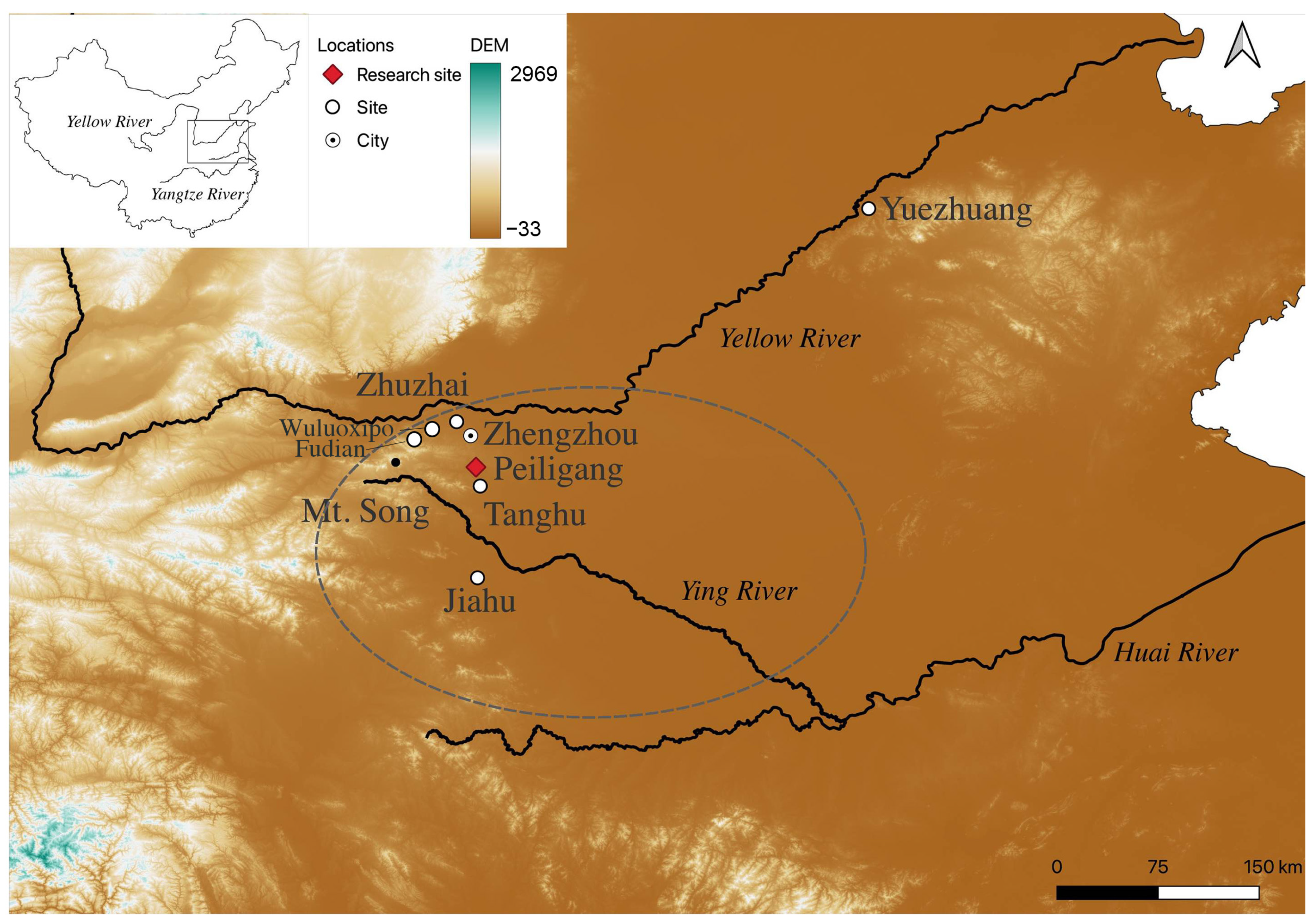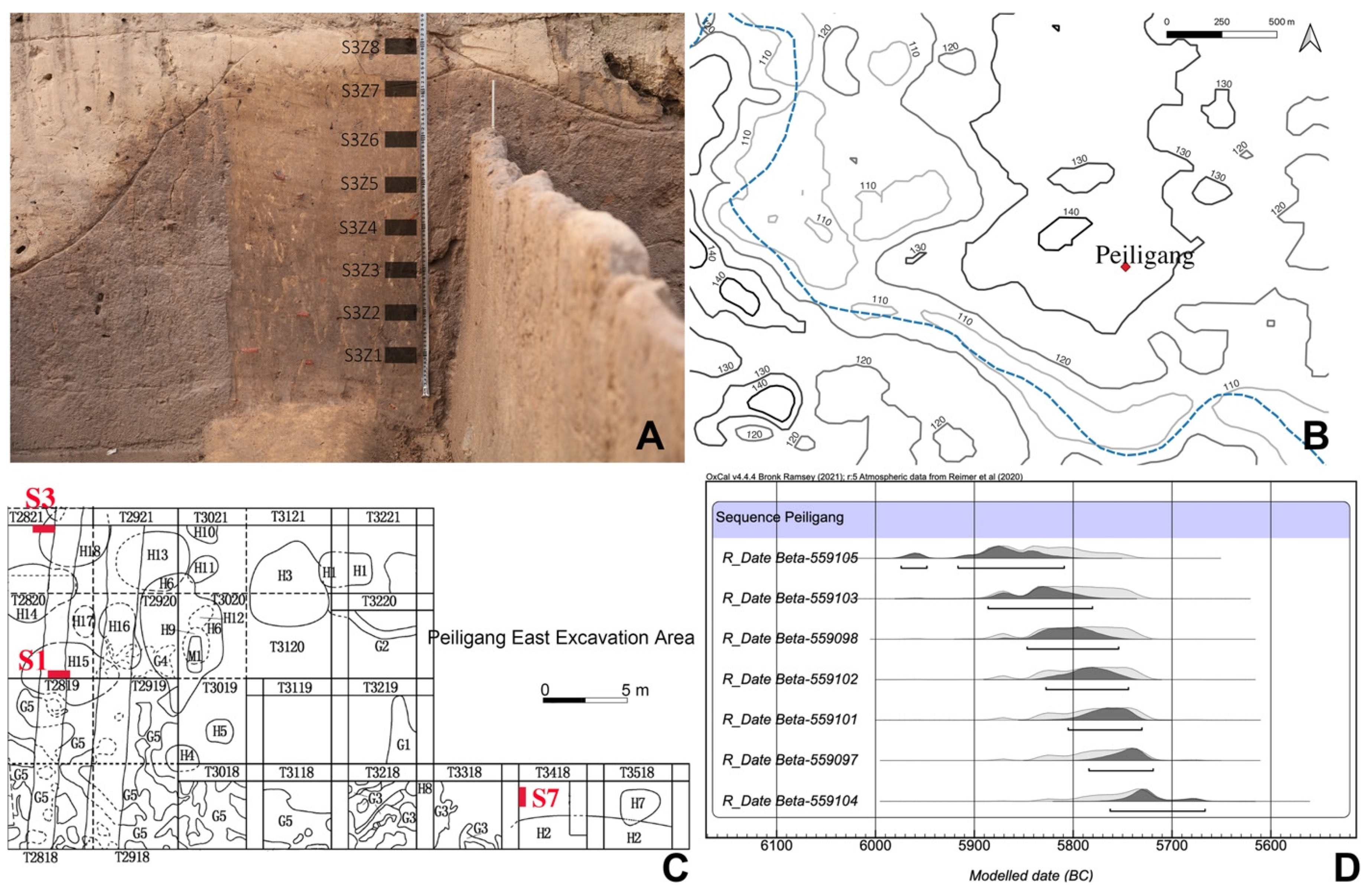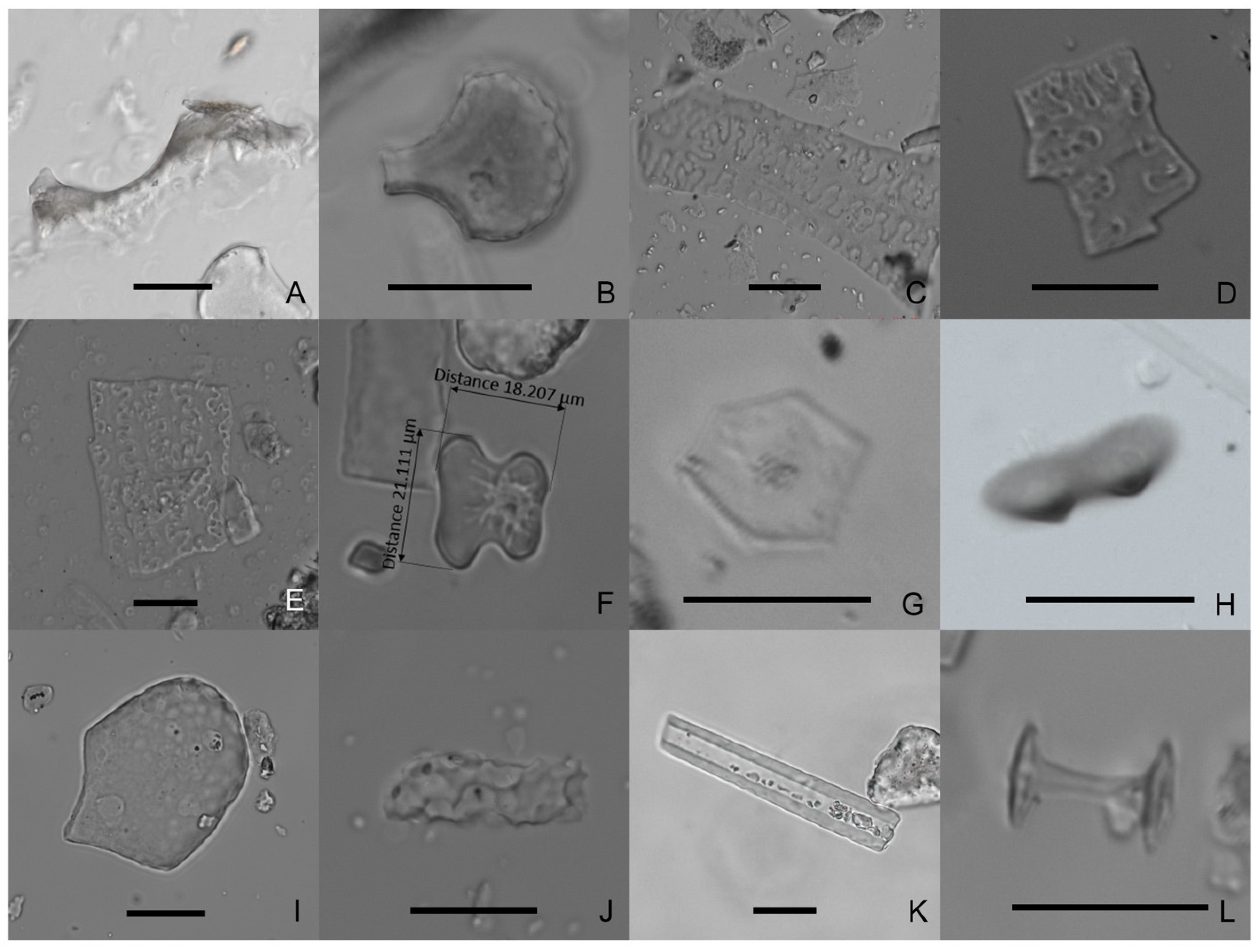An Interplay of Dryland and Wetland: Millet and Rice Cultivation at the Peiligang Site (8000–7600 BP) in the Middle Yellow River Valley, China
Abstract
1. Introduction
2. Environmental and Archaeological Background
3. Materials and Methods
4. Results
5. Discussion
5.1. Peiligang Plant Resources
5.2. The Environmental Condition at Peiligang
5.3. Harvesting and Processing of Rice and Millet
5.4. Development of Multi-Cropping Cultivation System
6. Conclusions
Supplementary Materials
Author Contributions
Funding
Data Availability Statement
Acknowledgments
Conflicts of Interest
References
- Zhao, Z. New Archaeobotanic Data for the Study of the Origins of Agriculture in China. Curr. Anthropol. 2011, 52, S295–S306. [Google Scholar] [CrossRef]
- Zheng, Y.; Crawford, G.W.; Jiang, L.; Chen, X. Rice Domestication Revealed by Reduced Shattering of Archaeological Rice from the Lower Yangtze Valley. Sci. Rep. 2016, 6, 28136. [Google Scholar] [CrossRef] [PubMed]
- Bestel, S.; Crawford, G.W.; Liu, L.; Shi, J.; Song, Y.; Chen, X. The Evolution of Millet Domestication, Middle Yellow River Region, North China: Evidence from Charred Seeds at the Late Upper Paleolithic Shizitan Locality 9 Site. Holocene 2014, 24, 261–265. [Google Scholar] [CrossRef]
- Weisskopf, A.; Deng, Z.; Qin, L.; Fuller, D.Q. The Interplay of Millets and Rice in Neolithic Central China: Integrating Phytoliths into the Archaeobotany of Baligang. Archaeol. Res. Asia 2015, 4, 36–45. [Google Scholar] [CrossRef]
- He, K.; Lu, H.; Zhang, J.; Wang, C.; Huan, X. Prehistoric Evolution of the Dualistic Structure Mixed Rice and Millet Farming in China. Holocene 2017, 27, 1885–1898. [Google Scholar] [CrossRef]
- Piperno, D.R. Phytoliths: A Comprehensive Guide for Archaeologists and Paleoecologists; AltaMira Press: Lanham, MD, USA, 2006; ISBN 978-0-7591-0385-6. [Google Scholar]
- Ball, T.; Chandler-Ezell, K.; Dickau, R.; Duncan, N.; Hart, T.C.; Iriarte, J.; Lentfer, C.; Logan, A.; Lu, H.; Madella, M.; et al. Phytoliths as a Tool for Investigations of Agricultural Origins and Dispersals around the World. J. Archaeol. Sci. 2016, 68, 32–45. [Google Scholar] [CrossRef]
- Harvey, E.L.; Fuller, D.Q. Investigating Crop Processing Using Phytolith Analysis: The Example of Rice and Millets. J. Archaeol. Sci. 2005, 32, 739–752. [Google Scholar] [CrossRef]
- Dal Corso, M.; Nicosia, C.; Balista, C.; Cupitò, M.; Dalla Longa, E.; Leonardi, G.; Kirleis, W. Bronze Age Crop Processing Evidence in the Phytolith Assemblages from the Ditch and Fen around Fondo Paviani, Northern Italy. Veget Hist. Archaeobot 2017, 26, 5–24. [Google Scholar] [CrossRef]
- An, J.; Kirleis, W.; Zhao, C.; Jin, G. Understanding Crop Processing and Its Social Meaning in the Xinzhai Period (1850–1750 Cal Bce): A Case Study on the Xinzhai Site, China. Veget Hist. Archaeobot 2022, 31, 261–277. [Google Scholar] [CrossRef]
- Portillo, M.; Albert, R.M.; Henry, D.O. Domestic Activities and Spatial Distribution in Ain Abū Nukhayla (Wadi Rum, Southern Jordan): The Use of Phytoliths and Spherulites Studies. Quat. Int. 2009, 193, 174–183. [Google Scholar] [CrossRef]
- Chen, F.H.; Dong, G.H.; Zhang, D.J.; Liu, X.Y.; Jia, X.; An, C.B.; Ma, M.M.; Xie, Y.W.; Barton, L.; Ren, X.Y.; et al. Agriculture Facilitated Permanent Human Occupation of the Tibetan Plateau after 3600 B.P. Science 2015, 347, 248–250. [Google Scholar] [CrossRef]
- Xiao, J.; Xu, Q.; Nakamura, T.; Yang, X.; Liang, W.; Inouchi, Y. Holocene Vegetation Variation in the Daihai Lake Region of North-Central China: A Direct Indication of the Asian Monsoon Climatic History. Quat. Sci. Rev. 2004, 23, 1669–1679. [Google Scholar] [CrossRef]
- Kaifeng Cultural Relics Committee; Xinzheng County Cultural Relics Committee. The Peiligang Neolithic Site in Xinzheng, Henan (Henan xinzheng peiligang xinshiqi shidai yizhi). Kaogu Archaeol. 1978, 2, 73–79. [Google Scholar]
- Archaeology Institute Henan Team One. Chinese Academy of Social Sciences 1979 Excavation Report of the Peiligang Site. Kaogu Xuebao 1984, 3, 23–52. [Google Scholar]
- Archaeology Henan Team One; Archaeology Institute; Chinese Academy of Social Sciences; Zhengzhou Municipal Institute of Cultural Relics and Archaeology. Xinzheng City Culture, Radio, Television, Tourism, and Sports Bureau, 2018-2019 Excavation at the Peiligang Site in Xinzheng, Henan (Henan Xinzheng Peiligang Yizhi 2018-2019 Nian Fajue). Kaogu Xuebao 2020, 4, 521–546. [Google Scholar]
- Smith, B.D. Low-Level Food Production. J. Archaeol. Res. 2001, 9, 1–43. [Google Scholar]
- Li, Y. The Subsistence Economy of the Peiligang Culture: Current Data and Reflections (Peiligang Wenhua Shengye Jingji Yanjiu Xianzhuang He Sikao). Nanfang Wenwu 2018, 4, 41–51. [Google Scholar]
- Lu, H.; Zhang, J.; Wu, N.; Liu, K.; Xu, D.; Li, Q. Phytoliths Analysis for the Discrimination of Foxtail Millet (Setaria Italica) and Common Millet (Panicum Miliaceum). PLoS ONE 2009, 4, e4448. [Google Scholar] [CrossRef]
- Duncan, N.A.; Starbuck, J.; Liu, L. A Method to Identify Job’s Tears, Coix Lacryma-Jobi L., Phytoliths in Northern China. J. Archaeol. Sci. Rep. 2019, 24, 16–23. [Google Scholar] [CrossRef]
- Ge, Y.; Lu, H.; Zhang, J.; Wang, C.; Gao, X. Phytoliths in Inflorescence Bracts: Preliminary Results of an Investigation on Common Panicoideae Plants in China. Front. Plant Sci. 2020, 10, 1736. [Google Scholar] [CrossRef]
- Madella, M.; Alexandre, A.; Ball, T. International Code for Phytolith Nomenclature 1.0. Ann. Bot. 2005, 96, 253–260. [Google Scholar] [CrossRef] [PubMed]
- Madella, M.; Jones, M.K.; Echlin, P.; Powers-Jones, A.; Moore, M. Plant Water Availability and Analytical Microscopy of Phytoliths: Implications for Ancient Irrigation in Arid Zones. Quat. Int. 2009, 193, 32–40. [Google Scholar] [CrossRef]
- D’Agostini, F.; Ruiz-Pérez, J.; Madella, M.; Vadez, V.; Kholova, J.; Lancelotti, C. Phytoliths as Indicators of Plant Water Availability: The Case of Millets Cultivation in the Indus Valley Civilization. Rev. Palaeobot. Palynol. 2023, 309, 104783. [Google Scholar] [CrossRef]
- Ge, Y.; Lu, H.; Wang, C.; Gao, X. Phytoliths in Selected Broad-Leaved Trees in China. Sci. Rep. 2020, 10, 15577. [Google Scholar] [CrossRef] [PubMed]
- Crawford, G.W.; Chen, X.; Luan, F.; Wang, J. People and Plant Interaction at the Houli Culture Yuezhuang Site in Shandong Province, China. Holocene 2016, 26, 1594–1604. [Google Scholar] [CrossRef]
- Bestel, S.; Bao, Y.; Zhong, H.; Chen, X.; Liu, L. Wild Plant Use and Multi-Cropping at the Early Neolithic Zhuzhai Site in the Middle Yellow River Region, China. Holocene 2017, 28, 195–207. [Google Scholar] [CrossRef]
- Zhang, J.; Lu, H.; Gu, W.; Wu, N.; Zhou, K.; Hu, Y.; Xin, Y.; Wang, C. Early Mixed Farming of Millet and Rice 7800 Years Ago in the Middle Yellow River Region, China. PLoS ONE 2012, 7, e52146. [Google Scholar] [CrossRef]
- Yin, C. The Study of Rice at Jiahu Site Based on Phytolith Analysis. Master’s Thesis, University of Science and Technology of China, Heifei, China, 2015. [Google Scholar]
- Liu, L.; Lee, G.-A.; Jiang, L.; Zhang, J. Evidence for the Early Beginning (c. 9000 Cal. BP) of Rice Domestication in China: A Response. Holocene 2007, 17, 1059–1068. [Google Scholar]
- Zhejiang Provincial Institute of Cultural Relics and Archaeology. Hemudu; Wenwu chubanshe (Cultural Relics Publishing House): Beijing, China, 2003. [Google Scholar]
- Liu, C.; Gu, H. Archaeobotanical Remains from Chengtoushan (Chengtoushan Yizhi de Zhiwu Yicun). In Chengtoushan in Lixian; Hunan Institute of Archaeology and Cultural Relics, International Research Center of Japanese Culture, Eds.; Wenwu Chubanshe: Beijing, China, 2007; pp. 98–106. [Google Scholar]
- d’Alpoim Guedes, J.; Jiang, M.; He, K.; Wu, X.; Jiang, Z. Site of Baodun Yields Earliest Evidence for the Spread of Rice and Foxtail Millet Agriculture to South-West China. Antiquity 2013, 87, 758–771. [Google Scholar] [CrossRef]
- Liu, L.; Duncan, N.A.; Chen, X.; Cui, J. Exploitation of Job’s Tears in Paleolithic and Neolithic China: Methodological Problems and Solutions. Quat. Int. 2018, 529, 25–37. [Google Scholar] [CrossRef]
- Ramsey, M.N.; Rosen, A.M. Wedded to Wetlands: Exploring Late Pleistocene Plant-Use in the Eastern Levant. Quat. Int. 2016, 396, 5–19. [Google Scholar] [CrossRef]
- Bettinger, R.L.; Wohlgemuth, E. Archaeological and Ethnographic Evidence Forvindigenous Plant Use in California. In Subsistence Economies of Indigenous North American Societies: A Handbook; Smith, B.D., Ed.; Smithsonian Institution Scholarly Press: Washington, DC, USA, 2011; pp. 113–130. ISBN 978-1-935623-01-4. [Google Scholar]
- Wang, H.; Chiou, S. Research on the Sustainable Development of Traditional Dwellings. Sustainability 2019, 11, 5333. [Google Scholar] [CrossRef]
- Lee, G.-A.; Crawford, G.W.; Liu, L.; Chen, X. Plants and People from the Early Neolithic to Shang Periods in North China. Proc. Natl. Acad. Sci. USA 2007, 104, 1087–1092. [Google Scholar] [CrossRef] [PubMed]
- Rasbold, G.G.; Calheira, L.; Domingos-Luz, L.; Pessenda, L.C.R.; Pinheiro, U.; McGlue, M.M. A Morphological Guide of Neotropical Freshwater Sponge Spicules for Paleolimnological Studies. Front. Ecol. Evol. 2023, 10, 1067432. [Google Scholar] [CrossRef]
- Liu, X.; Jones, P.J.; Motuzaite Matuzeviciute, G.; Hunt, H.V.; Lister, D.L.; An, T.; Przelomska, N.; Kneale, C.J.; Zhao, Z.; Jones, M.K. From Ecological Opportunism to Multi-Cropping: Mapping Food Globalisation in Prehistory. Quat. Sci. Rev. 2019, 206, 21–28. [Google Scholar] [CrossRef]
- Stevens, C.J. An Investigation of Agricultural Consumption and Production Models for Prehistoric and Roman Britain. Environ. Archaeol. 2003, 8, 61–76. [Google Scholar] [CrossRef]
- Wang, E.; Wang, J.; Zhu, X.; Hao, W.; Wang, L.; Li, Q.; Zhang, L.; He, W.; Lu, B.; Lin, H.; et al. Control of Rice Grain-Filling and Yield by a Gene with a Potential Signature of Domestication. Nat. Genet. 2008, 40, 1370–1374. [Google Scholar] [CrossRef]
- Murphy, K.M. A Quiet Harvest: Linkage between Ritual, Seed Selection and the Historical Use of the Finger-Bladed Knife as a Traditional Plant Breeding Tool in Ifugao, Philippines. J. Ethnobiol. Ethnomed. 2017, 13, 3. [Google Scholar] [CrossRef]
- Miles, D. The Finger Knife and Ockham’s Razor: A Problem in Asian Culture History and Economic Anthropology. Am. Ethnol. 1979, 6, 223–243. [Google Scholar] [CrossRef]
- Zhang, J.; Chen, Z.; Lan, W.; Yang, Y.; Wuhong, L.; Lin, Y.; Yin, C. Henan Wuyang Jiahu Yizhi Zhiwu Kaogu Yanjiu de Xinjingzhan (New Data from Botanical Remains the Jiahu, Henan). Kaogu Archaeol. 2018, 460, 101–110. [Google Scholar]
- Li, W. Foodways in Early Farming Societies: Microwear and Starch Grain Analysis on Experimental and Archaeological Grinding Tools from Central China. Ph.D. Dissertation, Leiden University, Leiden, The Netherlands, 2020. [Google Scholar]
- Cui, Q.; Zhang, J.; Yang, Y.; Sun, Y. Henan Wuyang Jiahu Yizhi Chutu Shiqi de Weihen Fenxi (Use-Wear Analysis of the Stone Tools from the Jiahu Site in Wuyang County, Henan Province). Acta Anthropol. Sin. 2017, 36, 478–498. [Google Scholar]
- Wang, J.; Zhu, J.; Lei, D.; Jiang, L. New Evidence for Rice Harvesting in the Early Neolithic Lower Yangtze River, China. PLoS ONE 2022, 17, e0278200. [Google Scholar] [CrossRef]
- Liu, L.; Chen, X. The Archaeology of China: From the Late Paleolithic to the Early Bronze Age; Cambridge University Press: Cambridge, UK, 2012; ISBN 978-0-521-64310-8. [Google Scholar]
- Wang, C.; Lu, H.; Gu, W.; Wu, N.; Zhang, J.; Zuo, X.; Li, F.; Wang, D.; Dong, Y.; Wang, S.; et al. The Spatial Pattern of Farming and Factors Influencing It during the Peiligang Culture Period in the Middle Yellow River Valley, China. Sci. Bull. 2017, 62, 1565–1568. [Google Scholar] [CrossRef]
- Yang, Y.; Cheng, Z.; Li, W.; Yao, L.; Li, Z.; Luo, W.; Yuan, Z.; Zhang, J.; Zhang, J. The Emergence, Development and Regional Differences of Mixed Farming of Rice and Millet in the Upper and Middle Huai River Valley, China. Sci. China Earth Sci. 2016, 59, 1779–1790. [Google Scholar] [CrossRef]
- Chen, F.; Xu, Q.; Chen, J.; Birks, H.J.B.; Liu, J.; Zhang, S.; Jin, L.; An, C.; Telford, R.J.; Cao, X.; et al. East Asian Summer Monsoon Precipitation Variability since the Last Deglaciation. Sci. Rep. 2015, 5, 11186. [Google Scholar] [CrossRef] [PubMed]
- Luo, W.; Gu, C.; Yang, Y.; Zhang, D.; Liang, Z.; Li, J.; Huang, C.; Zhang, J. Phytoliths Reveal the Earliest Interplay of Rice and Broomcorn Millet at the Site of Shuangdun (ca. 7.3–6.8 Ka BP) in the Middle Huai River Valley, China. J. Archaeol. Sci. 2019, 102, 26–34. [Google Scholar] [CrossRef]
- Tian, C.; Liao, W.; Yao, Y.; Liang, H.; Yi, Z.; Huang, S.; Bae, C.J.; Wang, W. New Lithic Evidence from Terminal Pleistocene-Early Holocene Zhongshan Rockshelter, Guangxi, Southern China. J. Archaeol. Sci. Rep. 2023, 49, 103916. [Google Scholar] [CrossRef]
- An, Z.; Porter, S.C.; Kutzbach, J.E.; Xihao, W.; Suming, W.; Xiaodong, L.; Xiaoqiang, L.; Weijian, Z. Asynchronous Holocene Optimum of the East Asian Monsoon. Quat. Sci. Rev. 2000, 19, 743–762. [Google Scholar] [CrossRef]
- Asouti, E.; Fuller, D.Q. A Contextual Approach to the Emergence of Agriculture in Southwest Asia: Reconstructing Early Neolithic Plant-Food Production. Curr. Anthropol. 2013, 54, 299–345. [Google Scholar] [CrossRef]
- Hastorf, C.A. The Social Archaeology of Food: Thinking about Eating from Prehistory to the Present; Cambridge University Press: Cambridge, UK, 2017; ISBN 978-1-107-15336-3. [Google Scholar]





Disclaimer/Publisher’s Note: The statements, opinions and data contained in all publications are solely those of the individual author(s) and contributor(s) and not of MDPI and/or the editor(s). MDPI and/or the editor(s) disclaim responsibility for any injury to people or property resulting from any ideas, methods, instructions or products referred to in the content. |
© 2023 by the authors. Licensee MDPI, Basel, Switzerland. This article is an open access article distributed under the terms and conditions of the Creative Commons Attribution (CC BY) license (https://creativecommons.org/licenses/by/4.0/).
Share and Cite
Wang, J.; He, Y.; Tang, Y.; Liu, L.; Li, Y.; Chen, X.; Gu, W. An Interplay of Dryland and Wetland: Millet and Rice Cultivation at the Peiligang Site (8000–7600 BP) in the Middle Yellow River Valley, China. Agronomy 2023, 13, 2130. https://doi.org/10.3390/agronomy13082130
Wang J, He Y, Tang Y, Liu L, Li Y, Chen X, Gu W. An Interplay of Dryland and Wetland: Millet and Rice Cultivation at the Peiligang Site (8000–7600 BP) in the Middle Yellow River Valley, China. Agronomy. 2023; 13(8):2130. https://doi.org/10.3390/agronomy13082130
Chicago/Turabian StyleWang, Jiajing, Yahui He, Yiyi Tang, Li Liu, Yongqiang Li, Xingcan Chen, and Wanfa Gu. 2023. "An Interplay of Dryland and Wetland: Millet and Rice Cultivation at the Peiligang Site (8000–7600 BP) in the Middle Yellow River Valley, China" Agronomy 13, no. 8: 2130. https://doi.org/10.3390/agronomy13082130
APA StyleWang, J., He, Y., Tang, Y., Liu, L., Li, Y., Chen, X., & Gu, W. (2023). An Interplay of Dryland and Wetland: Millet and Rice Cultivation at the Peiligang Site (8000–7600 BP) in the Middle Yellow River Valley, China. Agronomy, 13(8), 2130. https://doi.org/10.3390/agronomy13082130





